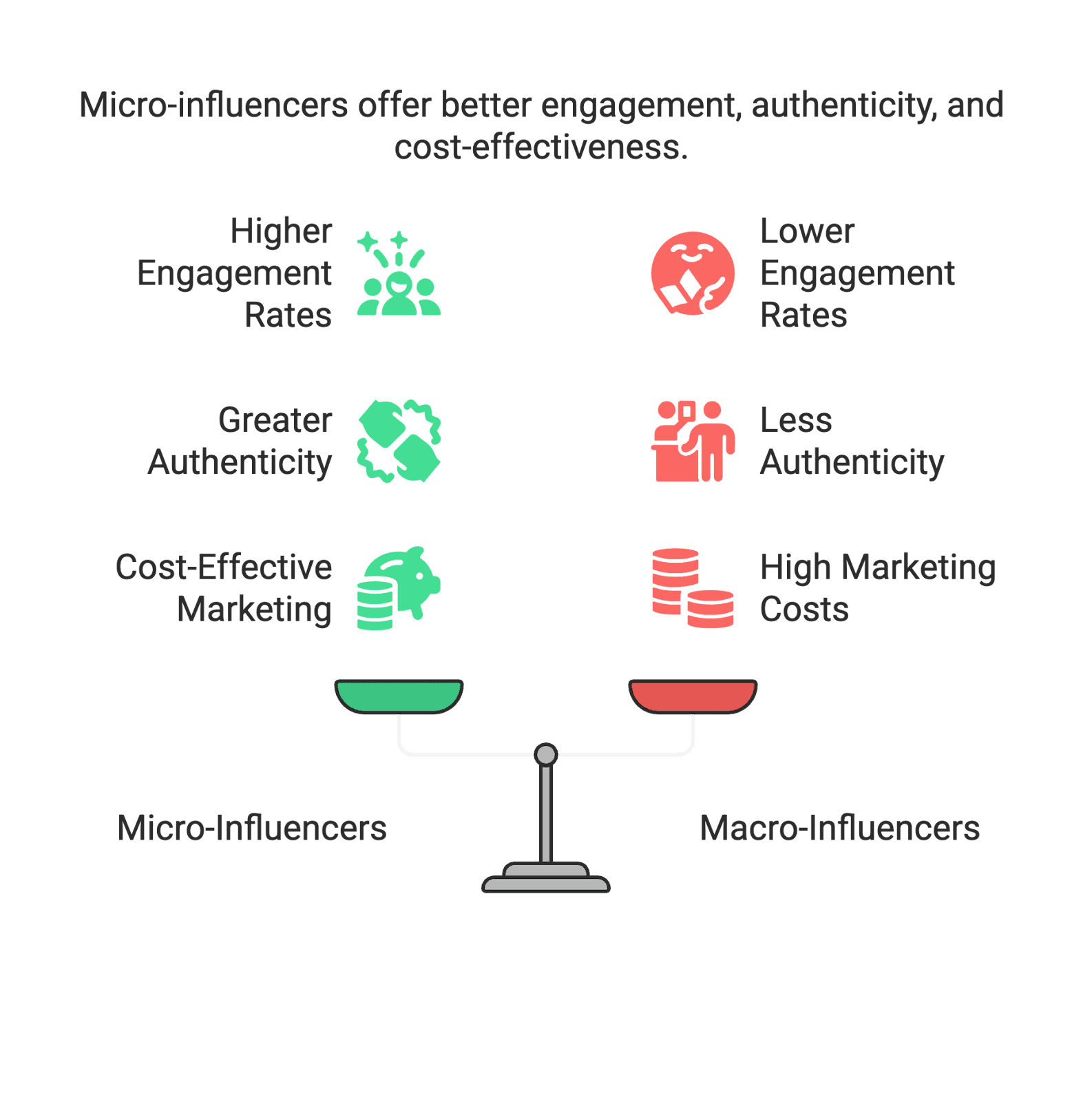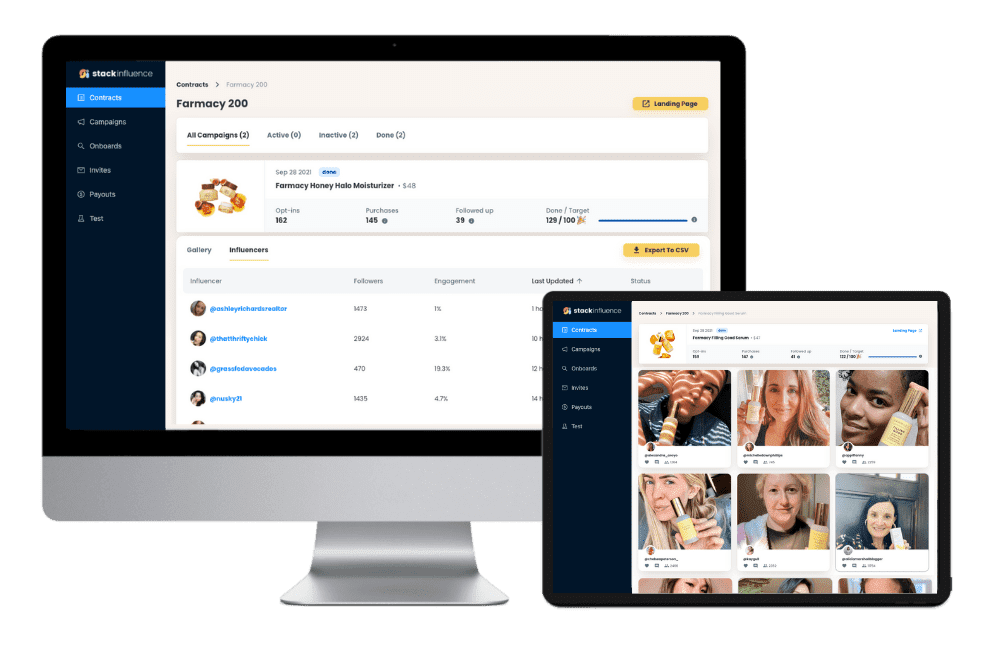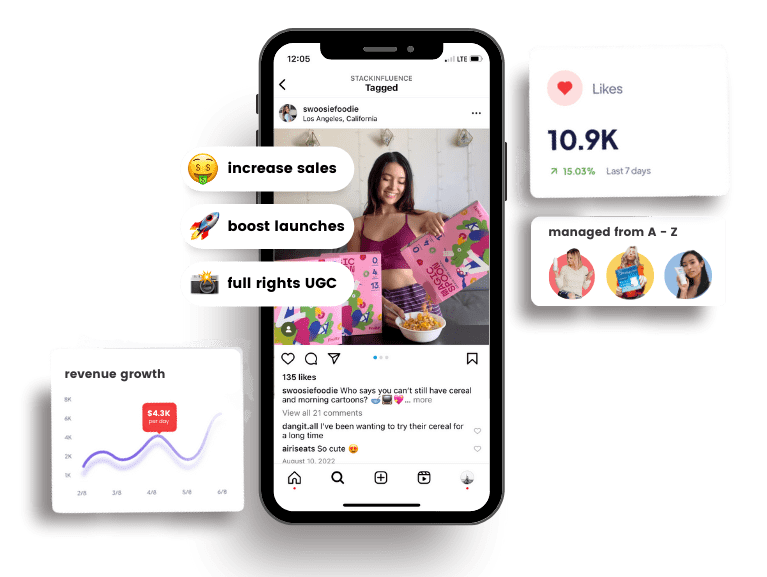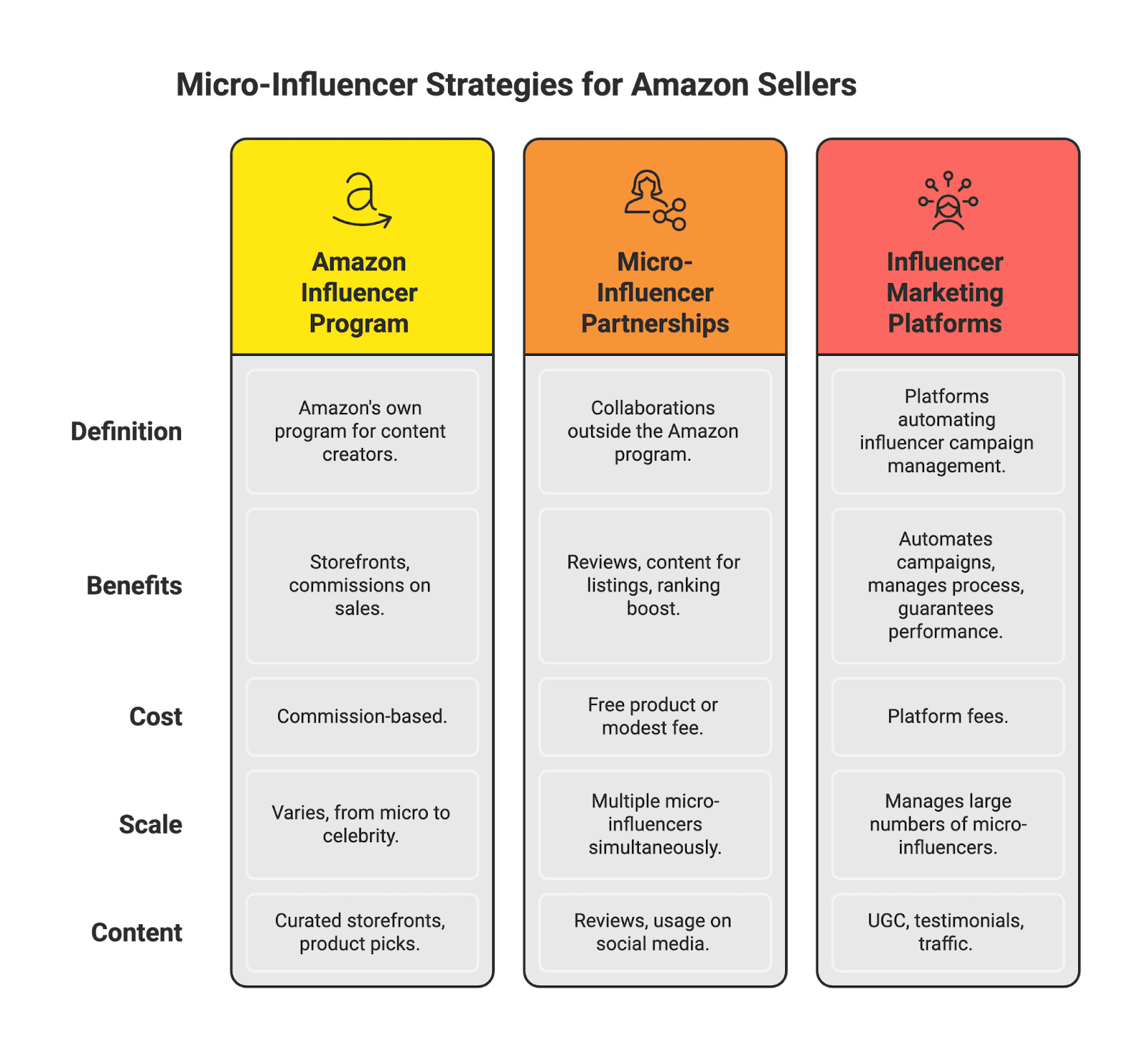Micro-Influencers and UGC in E-Commerce: How Content Creators Help Amazon Sellers Thrive
23rd
July, 2025
Influencer Marketing
Amazon Marketplace
Artificial Intelligence
TikTok Tips
In the ultra-competitive world of e-commerce, brands and Amazon sellers are turning to micro influencers and content creators to gain an edge. These niche creators – often everyday people with dedicated followings – help generate authentic user-generated content (UGC) and build consumer trust in ways traditional ads struggle to match. From engaging social media posts to credible product reviews, micro-influencers are proving to be a powerful resource for driving online sales and brand growth.
What Are Micro-Influencers and Why They Matter

Micro-influencers are social media personalities with relatively small but highly engaged audiences (typically in the few thousand up to ~100,000 follower range). Unlike celebrity “macro” influencers, micro-influencers operate in specific niches and feel like peers to their followers. They might be passionate hobbyists, bloggers, or experts in a particular domain, and their recommendations come off as genuine advice rather than paid advertisements. This authenticity and relatability give micro-influencers outsized influence over purchasing decisions.
Some key advantages of micro-influencers include:
- Higher Engagement Rates: Micro-influencers often enjoy far greater engagement on their posts than big influencers. It’s common to see engagement rates of 5–20% of their followers interacting with content, whereas macro influencers (hundreds of thousands or millions of followers) only see about 1–3% engagement on average. In other words, a micro creator with 10k followers might get 1,000+ likes/comments on a post (~10%), while a celebrity with 1M followers might only get 20k (~2%). This means micro audiences are actively paying attention and responding to content. Higher engagement not only boosts visibility (thanks to social media algorithms) but also signals a loyal community more likely to act on recommendations.
- Authenticity and Trust: Because they are “regular people” focused on a specific interest or community, micro-influencers come across as more genuine and trustworthy. Their content feels like a personal recommendation rather than a polished ad, which resonates with consumers. In fact, 82% of consumers in one survey said they are “highly likely” to follow a micro-influencer’s recommendation. This aligns with Nielsen’s finding that 84% of people trust peer recommendations over traditional advertising. Followers see micro-influencers as relatable friends or experts, so a shout-out from them carries credibility that a brand’s self-promotion cannot match. No wonder nearly 90% of consumers say authenticity is important when deciding which brands to support.
- Niche Targeting and Local Reach: Micro-influencers typically cater to a specific niche or demographic, which is gold for targeted marketing. Whether it’s a vegan foodie with 8,000 followers or a tech gadget reviewer with 50,000 subscribers, these creators attract audiences deeply interested in those topics. Brands can partner with micro-influencers whose followers closely match the product’s target market, often even in specific regions. For example, a U.S. supplement brand could work with a fitness micro-influencer in Germany to reach German gym-goers, or a baby products seller might collaborate with a parenting blogger in Brazil to connect with Brazilian moms. This kind of precise audience alignment means the influencer’s fans are exactly the potential customers the brand wants to reach, leading to higher relevancy and conversion rates.
- Cost-Effective Marketing (Better ROI): Partnering with micro-influencers is typically budget-friendly, especially compared to famous influencers or paid advertising. Many micro-influencers will promote products for just a free sample or a few hundred dollars, whereas a single post from a mega-influencer can cost tens of thousands of dollars. For the price of one celebrity endorsement, a brand could hire dozens of micro-influencers, multiplying its reach and content output. This low cost combined with strong engagement often translates to a higher return on investment (ROI). Case in point: one study found micro/nano-influencer campaigns can deliver around a 20:1 ROI (20 dollars in revenue per $1 spent) versus roughly 6:1 ROI for macro-influencers. In short, micro-influencers “punch above their weight,” providing more bang for your marketing buck by delivering authentic reach and conversions at a fraction of the cost.
In sum, micro-influencers may lack giant follower counts, but they excel at sparking genuine conversations and trust. Their recommendations feel like advice from a friend, leading audiences to engage and buy in ways they wouldn’t from a generic ad. Next, we’ll look more closely at how micro-influencers stack up against macro influencers on key metrics.

Unlock the Power of Micro Influencers and Elevate your Brand Today!

Micro vs. Macro Influencers: Engagement and ROI Comparison
Comparison of micro vs. macro influencer performance. The chart above compares micro-influencers and macro-influencers on two crucial metrics: average engagement rate and marketing ROI. As shown, micro-influencers tend to have significantly higher engagement on their content – roughly around 10% of their followers engage on average, compared to only about 2% for macro influencers. This means a far greater portion of a micro-influencer’s audience is actively liking, commenting, and clicking, which is invaluable for spreading a brand’s message. Moreover, micro-influencer campaigns often yield a much better return on investment – on the order of 20:1 ROI versus ~6:1 ROI for campaigns with big influencers. In practical terms, that means a dollar spent on a micro-influencer campaign can generate roughly 3× or more the sales of a dollar spent on a celebrity influencer campaign. The higher ROI is driven by the combination of lower costs and more engaged, receptive audiences.
Why do micro-influencers outperform larger influencers so dramatically? It comes down to trust and relevance. Followers view micro-influencers as authentic peers, so their recommendations carry weight – their engagement isn’t just vanity metrics, it reflects genuine interest. By contrast, macro influencers, despite their huge reach, often see diminishing returns: their audiences are so broad and inundated with sponsorships that any given post feels less personal and persuasive. In fact, research found that nano- and micro-influencers achieved roughly double the sales conversion rate of macro influencers in one analysis (about 7% of engagements converting to sales for small influencers vs. 3% for large influencers). The personal touch of smaller creators clearly translates into action from their followers. And because micro-influencers are far less expensive to work with, the ROI per marketing dollar can be startlingly high. Instead of paying $20,000+ for one macro influencer post, a brand could sponsor 50 micro-influencer posts at $400 each and likely generate far more total engagement and sales. This efficiency is exactly why micro-influencer marketing has exploded in popularity among savvy e-commerce brands.
The Power of UGC (User-Generated Content) in E-Commerce
Micro-influencers don’t just drive sales directly – they also produce user-generated content (UGC) that can amplify your brand’s credibility and reach. UGC refers to any content created by real users or customers, such as social media posts, reviews, photos, videos, or testimonials, rather than by the brand itself. In the age of social media, UGC has become marketing gold. Consumers trust content from real people far more than polished brand advertisements. In fact, a whopping 90% of consumers say authenticity is important when deciding which brands to support, and user-generated content is viewed as the most authentic form of content by consumers globally. By showcasing real-life product experiences and honest opinions, UGC serves as digital word-of-mouth – the modern “friend’s recommendation.”
It’s no surprise, then, that UGC heavily influences purchasing decisions. 79% of people say UGC highly impacts their purchase decisions, far more than traditional brand content. Shoppers are more likely to trust a fellow customer’s Instagram post or an unboxing video than a slick ad copy from the brand. Micro-influencers play a pivotal role here: the content they create (product reviews, demo videos, before-and-after photos, etc.) is essentially UGC from a semi-peer. Their posts are often unfiltered and relatable, showing products in real-life use. This kind of content not only builds trust with the influencer’s followers, but can also be repurposed by the brand across other channels. For example, an influencer’s photo or testimonial can be shared on the brand’s own social media or featured on product pages, adding social proof. Many brands even turn influencer UGC into ads – which tends to outperform traditional ads. (Studies show UGC-based ads get significantly higher click-through rates and lower cost-per-click than typical branded ads.)
Another benefit is the longevity and virality of influencer content. When a micro-influencer posts about your product, that content stays online and can continue to garner views, likes, and comments for days, weeks, or even longer. Essentially, you keep getting “free” impressions after the initial post, as new people discover it. In contrast, a paid ad stops working the moment your budget runs out. Good UGC can also snowball: people tag friends or share the post, leading to secondary reach that you didn’t even pay for. This kind of organic word-of-mouth effect is incredibly valuable – word-of-mouth marketing generates more than twice the sales of paid advertising on average. By sparking conversations and sharing, micro-influencer content can produce a ripple effect of brand awareness that far exceeds the initial audience.
In summary, UGC is a trust multiplier for e-commerce. Micro-influencers supply a steady stream of authentic content that humanizes your brand and builds credibility with customers. When potential buyers see real people (especially people they admire or relate to) genuinely enjoying your product, it diminishes skepticism and encourages them to buy. This fusion of influencer marketing and UGC is a one-two punch: you get both immediate promotion to the influencer’s followers and enduring social proof in the form of content that lives on. For Amazon sellers and online brands, leveraging UGC through micro-influencers can significantly boost conversion rates and customer loyalty.
How Amazon Sellers Leverage Micro-Influencers for Growth

Amazon’s dominance in online retail makes it a critical battleground for sellers – the platform accounts for about 38% of the U.S. online retail market, and nearly two-thirds of online shoppers start their product searches on Amazon. This means success on Amazon often determines overall e-commerce success. Micro-influencers offer Amazon sellers a powerful way to stand out and drive sales within this ecosystem, by merging social media influence with Amazon’s built-in shopper base.
One way Amazon sellers tap into influencer marketing is via Amazon’s own Influencer Program. This program lets approved content creators (from micro-influencers to celebrities) set up their own Amazon storefronts – basically, curated pages on Amazon where influencers list products they recommend, and earn commissions on any sales they drive. These Amazon influencers will often promote their storefronts and product picks on social media (you’ve probably seen hashtags like #AmazonFinds or #TikTokMadeMeBuyIt). When an influencer features your product on their Amazon storefront and tells their followers about it, it creates a seamless path: the audience can click through directly to Amazon and purchase with trust, since it’s a recommendation from someone they follow. This blend of content and commerce is incredibly potent. It not only generates immediate sales, but the external traffic and sales can boost your product’s ranking within Amazon’s search results, helping your item show up higher when people search on Amazon. In essence, micro-influencers can funnel outside interest into Amazon, which Amazon’s algorithm rewards, creating a virtuous cycle of more visibility and sales (a win-win for the seller).
Even outside of the official Amazon Influencer storefront program, micro-influencer partnerships benefit Amazon sellers in numerous ways. For instance, an Amazon seller can provide a micro-influencer with a free product (or discount code) in exchange for the influencer sharing their honest review or usage of the item on Instagram, TikTok, YouTube, etc. The influencer’s followers get to see the product in action from a trusted voice, and the post can include a direct Amazon product link or affiliate link. When those followers click through to Amazon and buy, the seller gains new customers and often new reviews on their product listing (as the buyers may leave feedback). Those authentic positive reviews and increased sales velocity will further improve the product’s ranking and conversion rate on Amazon. Additionally, the influencer’s content (photos, videos) can be used in the Amazon listing itself if applicable – for example, short video reviews or unboxing videos can be uploaded to the listing page or used in Amazon Posts/Live. This user-generated content enhances the Amazon listing, making it more convincing to future shoppers.
Crucially, micro-influencer marketing is a cost-effective strategy for Amazon sellers, especially compared to Amazon’s internal advertising costs. Amazon Pay-Per-Click (PPC) ad bids have been rising steeply, squeezing sellers’ profit margins. Rather than spending hundreds or thousands on PPC clicks that shoppers might ignore, sellers can often work with micro-influencers for the cost of a free product or a modest fee. For example, instead of paying $1000 for Amazon Sponsored Product ads, that budget could seed 10 micro-influencers with your product. Each of those influencers might create a review video or social post that not only reaches a targeted audience but also produces reusable content and lasting social proof. The content feels organic (not an ad), which is important given many consumers are “ad-blind” on platforms. Especially for new or unknown brands on Amazon, micro-influencers serve as trust bridges to skeptical customers in a way PPC ads cannot. A favorite influencer’s recommendation makes your Amazon product feel vetted and popular. It’s telling that 72% of teenagers (a key demographic of new consumers) follow influencers and trust their product recommendations – illustrating how powerful creator endorsements have become in shaping shopping habits.
To maximize impact, Amazon sellers often work with multiple micro-influencers simultaneously to broaden reach while keeping authenticity high. Rather than one celebrity who might generate a spike of traffic, a team of many micro-influencers can produce a steady stream of diverse content and referrals. In fact, marketing experts note that brands sometimes collaborate with dozens or even hundreds of micro-influencers in a single campaign to scale up exposure while still maintaining that personal touch. Each micro-influencer brings their own niche audience to the table, so by casting a wide net, you capture a variety of customer segments. This “many small voices” approach can outperform a single big voice, both in total reach and in the richness of UGC produced. And thanks to the relatively low cost of micro-influencers, this strategy is accessible even to small Amazon sellers with limited budgets.
Of course, coordinating such campaigns can be challenging – reaching out to many individuals, sending products, tracking posts, etc. This is where specialized influencer marketing platforms like Stack Influence come in. Stack Influence, for example, is a platform that automates product seeding campaigns and manages the end-to-end process of working with a large number of micro-influencers. It helps brands accumulate authentic UGC, testimonials, and traffic at scale, with campaigns 100% managed from A to Z. By using a platform or agency experienced in influencer marketing, Amazon sellers can save time on finding and vetting creators, ensure each influencer delivers the agreed content, and only pay for results. (Many platforms guarantee performance – e.g. you pay only when an influencer has posted as required.) Leveraging such tools allows even one-person businesses to execute large-scale micro-influencer campaigns efficiently, turning what could be a logistical headache into a streamlined process.

Unlock the Power of Micro Influencers and Elevate your Brand Today!

Tips for Running a Successful Micro-Influencer Campaign
If you’re an e-commerce brand or Amazon seller ready to dive into micro-influencer marketing, here are some best practices to ensure your campaign is effective:
- Define Your Goals and Target Audience: Start by clarifying what you want to achieve (e.g. increase Amazon product sales, grow brand awareness on Instagram, gather UGC for ads) and who your target customer is. This will guide you in choosing the right influencers. For instance, if you sell organic skincare, your goal might be to generate reviews and sales among young women interested in clean beauty, so you’d target micro-influencers in that niche.
- Find Relevant Micro-Influencers: Search for creators who operate in your product’s niche and have followings that align with your target market. Use social media and hashtags as discovery tools – e.g. look on Instagram or TikTok for hashtags like #amazonfinds, #[YourIndustry]Tips, or niche tags (#mommylife, #fitnessgear, etc.) to spot influencers who frequently recommend products. Don’t forget YouTube (many micro-influencers do product review videos) and even Amazon’s own channels (Amazon Live streams, #FoundItOnAmazon posts). Influencer marketing platforms or databases can also speed up this process by listing creators by category and engagement metrics. The key is to make a list of potential partners whose content and audience are a good fit for your brand.
- Vet for Authenticity and Engagement: Before reaching out, evaluate each influencer’s quality. Don’t be swayed just by follower count – check their engagement rate and audience interaction. A micro-influencer with 5k followers and a 10% engagement rate (500 likes per post) is usually more valuable than one with 50k followers but a 1% engagement rate. Look at the comments on their posts: are people asking questions, showing genuine interest? Also, scroll through their content to ensure it aligns with your brand values and that they produce content regularly. Authenticity is crucial; you want someone whose feed isn’t 100% ads, but rather a person who truly shares useful or entertaining posts and has built trust with followers.
- Reach Out with a Win-Win Proposal: When contacting micro-influencers, be clear and professional about what you’re offering and what you’d like in return. Micro-influencers are often happy to collaborate, but you need to spell out the terms. For example, you might offer a free product (and/or payment or commission) in exchange for an Instagram post, a TikTok video review, and perhaps the inclusion of your product on their Amazon storefront. Highlight any benefits to them – free product to try, affiliate commissions on sales, exposure to your brand’s audience if you’ll reshare their content, etc. Make the process easy: explain how you will deliver the product, any guidelines or key points to mention, and emphasize honest feedback. The more straightforward and attractive your proposal, the more likely influencers will say yes. If you’re using a platform like Stack Influence to manage the campaign, much of this will be handled through the platform’s campaign brief and agreements, but it’s still wise to communicate expectations clearly.
- Allow Creative Freedom (within Guidelines): While you should provide influencers with the important details about your product and any must-say points (or required disclosures like #ad or #AmazonInfluencer if applicable), it’s best to let the content creators use their own voice and style to promote your product. They know their audience best, and authenticity is key. If an influencer’s style is comedic, encourage them to incorporate your product into a funny skit; if they’re more informative, perhaps a how-to or honest review works better. Trusting the influencer to create content that fits their persona will result in more genuine, engaging posts. You can always ask to check the content before it’s posted if you have concerns, but avoid over-directing them like a rigid ad – the beauty of UGC is its organic feel.
- Monitor Results and Build Relationships: Once your micro-influencers start posting, keep track of the outcomes. Use unique affiliate links or discount codes to measure how much traffic and sales each influencer is driving to your Amazon listing or website. Watch for spikes in Amazon page visits or conversions when posts go live. Equally important, note the content itself and how the audience reacts – this can teach you which angles or formats work best. After the campaign, collect the best UGC (get permission if you plan to reuse an influencer’s photos/videos in your own marketing) and consider featuring it on your product pages or social channels, since it can continue to influence other shoppers. Finally, nurture ongoing relationships with the influencers who performed well. Thank them, share their posts, maybe send them another product release down the line. By turning one-off collaborations into long-term partnerships, you build a network of brand ambassadors who consistently create buzz for your products. Many brands that invest in such relationships end up with an “always-on” micro-influencer team, continuously driving UGC and word-of-mouth for the brand. As those creators grow over time, your brand’s reach grows with them.
By following these steps, even small sellers can gradually develop a robust micro-influencer marketing strategy that complements their other sales tactics. It does require effort up front – researching and coordinating with multiple people – but the payoff in authentic exposure and customer trust can be game-changing.
Conclusion
In today’s social media-driven commerce landscape, micro-influencers and UGC have become indispensable assets for e-commerce success. They inject authenticity, trust, and community engagement into your marketing efforts – qualities that are hard to achieve with traditional advertising alone. For Amazon sellers, in particular, partnering with micro-influencers and content creators can be the differentiator that propels your product to the top of search results and into countless shopping carts. The data is clear: smaller creators often deliver higher engagement and better ROI than their larger counterparts, all while creating a wealth of content that can be repurposed to further amplify your brand message. And with consumers increasingly skeptical of ads but receptive to peer influence, this approach aligns perfectly with what modern shoppers trust.
In summary, micro-influencers, content creators, and UGC represent a powerful combination for any e-commerce brand or Amazon seller looking to thrive. By embracing the authentic connection these creators foster with consumers, you can supercharge your marketing strategy – boosting credibility, expanding reach, and ultimately driving more conversions. In a market where trust is the new currency, tapping into the “small but mighty” influence of everyday creators can yield outsized rewards for your business. So, start small and scale up: your future customers are waiting to hear about you from the voices they trust. By investing in micro-influencers now, you’ll build a foundation of genuine advocacy that can keep your brand growing for years to come.

By William Gasner
CMO at Stack Influence
William Gasner is the CMO of Stack Influence, he's a 6X founder, a 7-Figure eCommerce seller, and has been featured in leading publications like Forbes, Business Insider, and Wired for his thoughts on the influencer marketing and eCommerce industries.
Want new articles before they get published? Subscribe to our Awesome Newsletter.
stack up your influence
turning creativity into currency
our headquarters
111 NE 1st St, Miami, FL 33132
our contact info
[email protected]
stack up your influence
turning creativity into currency
our headquarters
111 NE 1st St, 8th Floor
Miami, FL 33132


